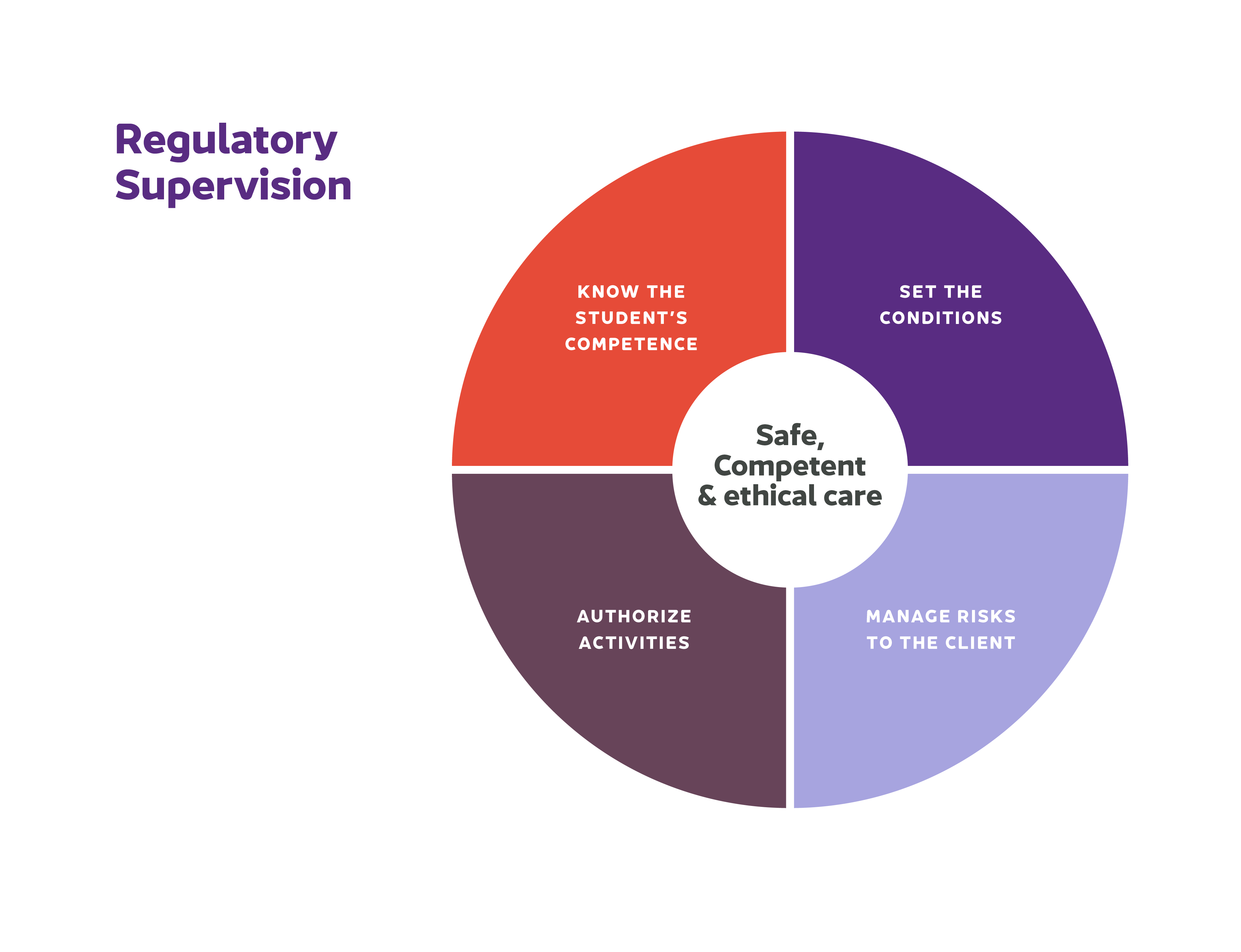You remember the nurse—perhaps many nurses—who guided your learning as a student. Maybe they were an instructor, a preceptor, or someone else, watching over your practice to ensure you provided your clients with safe, competent care.
What will I learn?
- What regulatory supervision entails
- A nurse's responsibilities when providing regulatory supervision
Standards
Regulatory supervision explained
Regulatory supervision is a process nurses follow when authorizing students to perform client-related activities (for example, assessments, treatments, interventions):
- In a clinical setting as part of their nursing education program/course
- While working as an employed student registrant (ESR)
Regulatory supervision is carried out by LPNs, NPs, RNs, and RPNs, except as noted otherwise, and is a professional responsibility.
As a student's supervising nurse, you're responsible and accountable for using your professional judgment when supervising their activities. This includes minimizing client risks by planning for situations you can reasonably expect to occur.
Nursing students and ESRs are
not authorized to perform any activities that affect a client unless they have gained competence through their education program and are authorized to do so by a nurse who holds BCCNM practicing registration.
When a student is an ESR, only RNs or RPNs can provide regulatory supervision for these student activities. LPNs do not provide regulatory supervision to ESRs. Students in an ESR role must also meet the principles of the Employed Student Registrant practice standard.
Students practise within the policies and expectations set by their education program and the clinical practice setting. Both the supervising nurse and the student are responsible and accountable for their own decisions and actions.
Education programs and workplaces provide supports and resources for nurses to safely provide regulatory supervision of students and to meet the BCCNM standards of practice.
Regulatory supervision process
Regulatory supervision is a responsibility shared between the supervising nurse, the student, and sometimes the student's instructor. Communication is key to the process' success.

The nurse's regulatory supervision responsibilities include:
- Step 1: Knowing the student's competence
You need to reasonably know the student's competence before proceeding with any client-related activities. You can find this information from their education program, their clinical instructor, a skills checklist, an outline of activities taught and observed to date, and by talking directly to the student.
Important: Clinical practice helps students consolidate the skills they have learned in their education program. They do not carry out activities for which they have not obtained the competence in their education program.
- Step 2: Authorizing activities the student may carry out
Based on the student's level of competence, you authorize client care activities you expect the student can safely perform.
As a supervising nurse, you can only supervise a student according to your own scope of practice and individual competence. This means that if an activity is not within your scope of practice, or you do not have the competence to carry it out, you cannot authorize a student to carry out the activity.
This is important when you are of a different nursing designation than the student (for example, an RN supervising an RPN student). Talk with the student about what activities they will perform, with which clients, and where they need support.
- Step 3: Setting conditions
At times, there will be an activity the student performs that requires you to be physically present or in frequent contact with the student, or that requires oversight by another health professional (e.g., another nurse, their instructor). This is called "setting a condition" for the activity. Setting conditions requires clear communication between you and the student, and with whoever will oversee them while they perform the activity.
- Step 4: Managing risks
Always consider risks to the client and take steps to ensure safe care—this is your priority. This includes checking with the student to see if the care went as planned, as well as evaluating the client's experience.
If the student does something that harms a client, you must take the necessary actions to manage client outcomes and get help as needed. Minimize client risks by using your professional judgment when authorizing student activities and planning for situations that would reasonably occur. You're not responsible or accountable for situations you could not reasonably foresee.
Regulatory supervision in action
(this scenario does not apply to supervision of ESRs)
Karyn, an RN, is working in home and community care. She is providing regulatory supervision to Rick, a third-year student in a community psychiatric nursing program.
Karyn talks to Rick about his knowledge and the skills gained in the program so far. They review the course outline and the skills checklist signed off by his instructors. She asks Rick which skills he is comfortable with and those he thinks he needs more experience with.
Together they work out a plan for their first week together, with Karyn planning for close supervision and observation of Rick's performance. If the week goes well, she will consider sending Rick out with Sara, an LPN, to provide care to stable clients with Sara overseeing the care Rick provides and reporting back to Karyn.
Karyn knows that as the supervising RN, she decides which activities to authorize Rick to perform, and that by asking Sara to oversee some of Rick's practice, she is setting a condition. She talks to Sara about her plan and what is expected, and Sara agrees to oversee Rick if all goes well in the first week.
At all times, Karyn monitors the outcomes of care and intervenes or changes the plan as needed to ensure client safety.